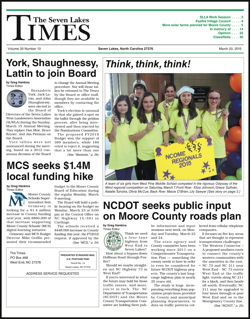 The Moore County Board of Commissioners met three times in closed session to consider an offer from Bojangles' to purchase 1.3 acres of county property in the Carriage Oaks Center in Carthage — on October 18, 2011, February 7, 2012, and May 15, 2012.
The Moore County Board of Commissioners met three times in closed session to consider an offer from Bojangles' to purchase 1.3 acres of county property in the Carriage Oaks Center in Carthage — on October 18, 2011, February 7, 2012, and May 15, 2012.
Almost everything said in those sixty minutes of debate, under North Carolina's Open Meetings Law, should have been discussed in open, not closed session, according to Attorney Mike Tadych, of Stevens Martin Vaughn & Tadych, PLLC, a Raleigh firm that specializes in Open Meetings and Public Records issues.
That's because, far from simply discussing how best to sell a piece of property, the five Commissioners used those meetings to debate how best to accommodate the future space needs of County government.
At the center of that debate lay two competing options:
• The expansion of the Carriage Oaks Center, favored by Commissioner Tim Lea, or
• The acquisition of thirty-two acres off Pinehurst Avenue in Carthage, near the current Moore County Office Park, to serve as the site for a new Administration Building, a option favored by Commissioner's Chairman Larry Caddell.
The offer from Bojangles landed annoyingly in the middle of this debate. But what was at first an annoyance came, for some Commissioners, to be seen as an opportunity -- as a source of cash that could pay for the Pinehurst Avenue expansion.
The NC General Statutes provide a handful of reasons that local governments may enter closed session deliberations. Discussing the County's strategy for addressing long-term space needs is not among them.
The Clerk to the Board posted audio recordings of the three closed sessions on the County website Thursday afternoon; the account that follows is based on a careful review of those recordings.
The Core Issue
The Bojangles' offer touched a key problem the Moore County Board of Commissioners faces -- one that Commissioner Nick Picerno explained during the May 15, 2102 Closed Session. Bringing Commissioner Craig Kennedy, the rookie on the Board, up to speed, Picerno explained that, when he joined the Board three years ago, one of the key goals was to develop "a vision of where the County would be in thirty to forty years: what property we would need, where people would be located, what would be the best for our citizens, where they would come and get their services, how we could consolidate."
"Unfortunately, we got into this war about the public safety center," Picerno continued," and we lost our vision. We really never had a vision. The vision never got to be placed out, kind of like these architects do, when they come in and set these models out and say 'This is what you want to do' -- we really never got there. "
"The reason I think we are having a study again done is to get back on the track of that vision . . . . We all [individually] may have a vision of what that looks like, but, without the facts behind it, we don't know what the best vision for the county is and how to best use our resources and taxpayers dollars would be."
Carriage Oaks vs. Pinehurst Avenue
The study that Picerno referred to is a recently-commissioned analysis of the County's need for space stretching 20-50 years into the future, as well as an assessment of how well current County buildings can meet those needs.
But, as Picerno suggested in his comments to Kennedy, some Commissioners already have their own visions, not carved in stone, but forged in previous debates about where to locate county offices and assets.
Throughout the closed session discussions, Commissioner Lea repeatedly returned to two points: the need to wait until the study results are in, and the possibility that the County could expand its facilities at Carriage Oaks. In the midst of the war over the public safety center, the Board had architects design a County Administration Building, first placing it on the Grimm property in downtown Carthage and then at Carriage Oaks.
Commissioner Caddell consistently parried Lea's Carriage Oaks thrusts, arguing that the site was unsuitable for expansion because of wetlands on the property and the location of the Veteran's Memorial right beside the Department of Social Services [DSS] -- the most logical spot for an initial expansion at Carriage Oaks.
Caddell's vision that emerges in the sixty minutes of closed session debate is, ultimately, to sell Carriage Oaks, after building one or more new buildings in the Moore County Office Park. In addition to placing DSS closer to the Health Department, that vision would return Carriage Oaks to private hands and the Town of Carthage's tax rolls. Sitting at the intersection of NC Highways 24/27 and 15-501, the property should be a prime candidate for future retail expansion and much more valuable to the town in private, rather than public, hands.
Caddell was Mayor of Carthage for many years, including the year in which the County purchased the then nearly vacant Carriage Oaks Shopping Center, taking it off the town's tax roles. And there may have been an unwritten agreement between the then-Mayor and then-Commissioners Chairman Paul Helms that the County would one day return Carriage Oaks to the Carthage tax base.
Using Bojangles' Cash to Fund Expansion
When the Board first discussed the Bojangles' offer, in October of 2011, no Commissioner showed much enthusiasm for pursuing the sale. But, nine months later, Caddell had apparently warmed to the idea of selling 1.3 acres at Carriage Oaks and using the proceeds to purchase the 32-acre Kirby property on Pinehurst Avenue.
"If you have a chance to sell a piece of property for $375,000 or $400,000 and turn around and buy 32 acres of land," Commissioner Caddell said, "it would be shortsighted not to look at it."
Later in the May 15 closed session, Commissioner Melton argued that, by selling the 1.3 acres "at the right price, that would upgrade the whole shopping center and make the rest of the property a whole lot more valuable." He expressed skepticism that the property had any value to the County for expansion purposes.
"If we could come up with a price on the high side of what it is worth," Melton said, "personally I would like the Board to consider selling it and go after another tract with that money."
Debate Grows Heated
Near the end of the May 15 closed session, the debate between Lea and Caddell grew quite rancorous, to the degree that Commissioner Jimmy Melton had to intercede. Lea said Caddell had told him, before Caddell joined the Board of Commissioners, that he wanted to sell the property beside of Hardee's. Caddell disputed that, but said "When I negotiated the shopping center, there were some negotiations with the County . . . . I tell you what we will do: We will bring Paul Helms down here and sit him in the room and ask him . . ."
Provoked by Lea's charges that he is "spinning" the facts, Caddell's anger rose: "You all can do anything you all want to do," Caddell said. "But just remember . . . that you represent all the people . . . . This happens to be my home town. I can't help it. This is where I live."
Just after that outburst, the Commissioners agreed to bring the Bojangles' offer into open session, though they did not, in that open session, reveal the amount that had been offered for the property, or anything about the larger debate the offer had triggered among the members of the Board.
Veteran's Memorial in a Precarious Spot
The Veteran's Memorial, placed at Carriage Oaks by a 2004 vote of the Commissioners, is a nagging fly in the ointment, no matter how the County meets its future needs for space. And the fact that the Memorial is located at Carriage Oaks may have been more an accident than the result of careful planning.
The issue of the Memorial came up briefly in the October 18, 2011 closed session.
"DSS, if they were going to expand, they should never have put the Memorial there," Caddell said. "If that was what the plans were, because they owned over an acre right beside it [DSS]."
"We tried to stop that," Lea replied.
The Memorial comes up again in the February 7, 2012 closed session.
Lea said he had spoken with Raymond Doby, a key organizer of the Memorial effort, when the decision about where to locate it was being made.
"I said 'Mr. Doby, it may be that the County agrees to put this Memorial here today, but sometime in the future, if we need to expand the building next door, then we may end up having to move that Memorial to another place.' And his comment back to me was, he said 'That's fine, as long as we've got one.'"
"I'd sure hate to move that thing," Caddell responded. "Man, I tell you what, you talk about a hot potato, son. That's like shooting yourself in the foot and saying: Ooo, that hurt."
Picerno said the Memorial should be located at Hillcrest Park, and Lea replied, "That's where we tried to get it to go, and politics got into it, and it went there [at Carriage Oaks]."
Caddell said the Town of Carthage offered a spot, but the organizing group and the Town Commissioners couldn't agree about saving two large pine trees on that site.
Later in the meeting, Lea returned to the issue, saying he understood "the sensitivity of moving the Memorial, but that was part of the understanding up front with those that located it there."
"Well, you can make that motion, Tim," Caddell replied. "In my humble opinion, that's never going to happen."
"Well," Lea replied, "obviously you wouldn't ever vote to do anything like that unless they were in agreement with it prior to taking that action."
In short, the Memorial is in a precarious spot.
If Lea's vision of expanding County offices at Carriage Oaks prevails, the Memorial sits upon the most obvious acreage for the expansion of the DSS offices. If Caddell's vision of ultimately returning Carriage Oaks to the private sector is realized, the Memorial would not only front onto a Bojangles' but would quite likely be surrounded by a retail shopping center.
Open Meetings Law
It is not clear whether the discussions in all closed sessions held by the Moore County Board of Commissioners range as widely over County strategy and policy as did these discussions prompted by the Bojangles' offer -- or whether the offer, because it touched on a core, unresolved debate, provoked the Board to venture far beyond the bounds the Open Meetings Law allows.
It is clear from the audio tapes that the County Attorney attempted to rope the Commissioners back into the very narrow question that it would have been proper to discuss in closed session: whether to use an auction, sealed bids, or a negotiation and upset bid process to sell the property. But the County Attorney is not a sergeant at arms with the power to stop debate.
According to Tadych, an attorney who makes a speciality of Open Meetings Law, nearly everything else that was said in the sixty minutes of debate on the Bojangles' offer should have been discussed in open session.
